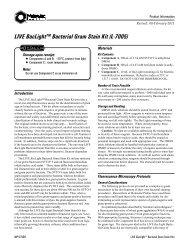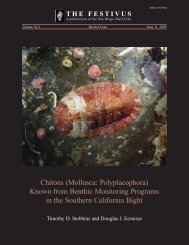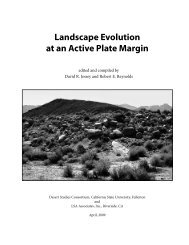Vertical Vegetation Structure Below Ground: Scaling from Root
Vertical Vegetation Structure Below Ground: Scaling from Root
Vertical Vegetation Structure Below Ground: Scaling from Root
You also want an ePaper? Increase the reach of your titles
YUMPU automatically turns print PDFs into web optimized ePapers that Google loves.
<strong>Vertical</strong> <strong>Vegetation</strong> <strong>Structure</strong> <strong>Below</strong> <strong>Ground</strong>: <strong>Scaling</strong> <strong>from</strong> <strong>Root</strong> to Globe 355and,for Ambrosia,also when its roots encountered other Ambrosia roots.Several studies published since 1991 have addressed the effects of rootcompetition on spatial root distributions,and their results have beenreviewed extensively by Schenk et al. (1999),de Kroon et al. (2003),andHutchings and John (2003). To briefly summarize the findings to date: (1)root growth in many species reacts to the presence of other roots; (2) in atleast some cases such reactions are triggered by signals between roots or byallelochemicals; (3) types of reactions differ depending on the speciesinvolved; and (4) reactions appear to be different when roots encounterroots <strong>from</strong> the same plant or <strong>from</strong> a separate plant. The overall ecologicaleffects of these mechanisms seem to be that they allow plants to shift rootgrowth to soil space unoccupied by roots,or,if such space is unavailable,to soil space occupied by roots of competitors,and to reduce intra-plantroot overlap.The overall effect at the community level of shifts in root distributionsin response to competition is that soil space is partitioned more efficientlyby roots than it would be without these mechanisms. For example,verticalroot distributions of some species may shift in response to interspecific rootcompetition and thus exhibit vertical niche partitioning (D’Antonio andMahall 1991; Mou et al. 1997; Leuschner et al. 2001; Schmid and Kazda2001). Niche partitioning by multiple species has been found to increaseresource use efficiency at the community level and thereby increase primaryproductivity (Loreau and Hector 2001). Partitioning of the soil spaceby roots of multiple species is likely to be complex and the patterns will bespecies-specific. It should not be assumed that different plant growth formsor functional types tend to partition the soil profile in a similar fashion indifferent ecosystems. For example,Heinrich Walter’s (1939) classic twolayerhypothesis of soil depth partitioning between woody and herbaceousplants,originally proposed for African savannas,does not appear to beuniversally applicable and may be largely restricted to relatively dry climates(Fig. 5; Schenk and Jackson 2002b).Regardless of whether root growth reacts to the presence of other roots,all terrestrial plant species have evolved under conditions of root competitionand are therefore likely to have evolved a root system architecture androot growth patterns that allow them to grow and survive in the presenceof competitors. As mentioned above,roots tend to proliferate in nutrientrichpatches of the soil,even though such proliferation may not in itselfincrease nutrient uptake rates. Instead it confers advantages by pre-emptingor reducing the use of such patches by competitors (Robinson et al.1999; Robinson 2001). The effect of such root proliferation in fertile patchesor soil layers will be that,within a soil profile,root densities will increasemore than linearly with nutrient concentrations. This may in part explain
















